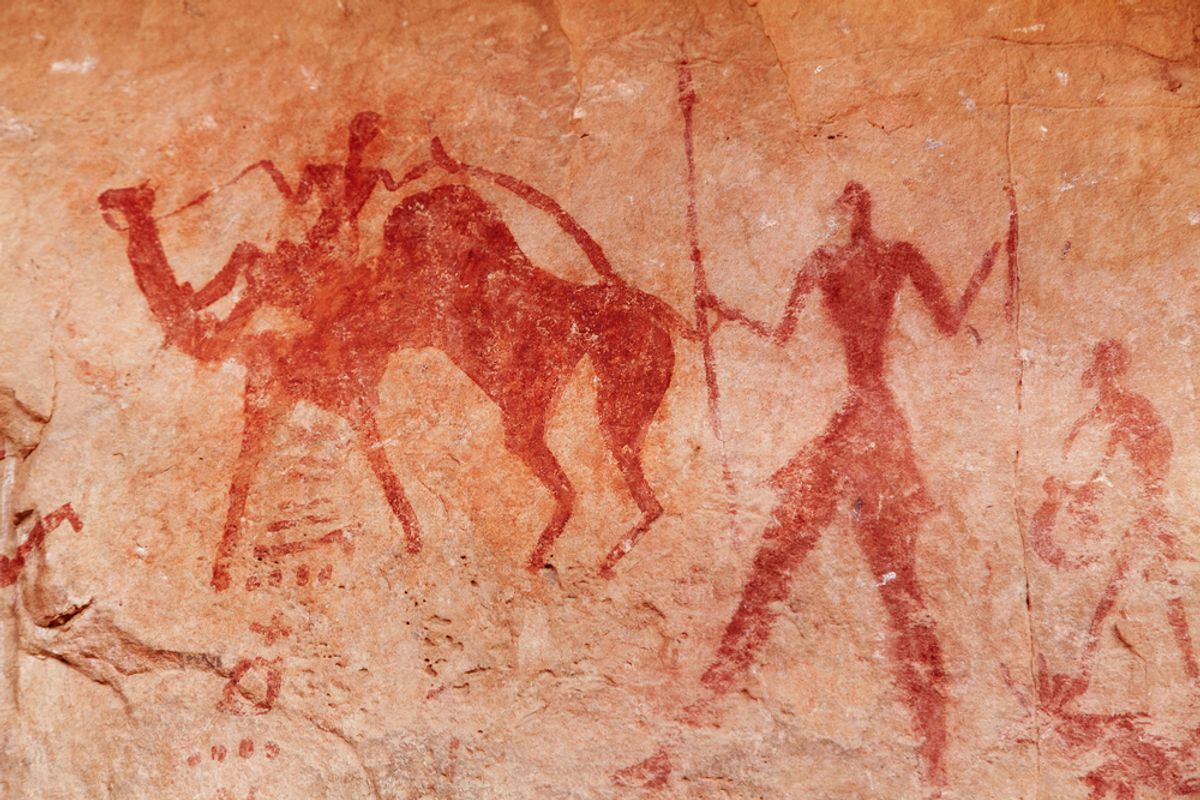Every single culture engages in some kind of art, whether that’s telling stories, dancing, weaving elaborate textiles, cooking, making jewelry or pottery, or painting landscapes and portraits. It’s so common that creating art, known to social scientists as “symbolic behavior,” seems to be an important part of what it means to be human.
Language is a type of symbolic behavior. For example, the sounds that make up the word “chair” don’t have any connection to an actual chair. English speakers have just agreed to share this audible symbol to refer to the objective reality, and different languages use different sounds to symbolize the same thing. But when did symbolic behavior begin? That’s a question archaeologists have been trying to answer for as long as there have been archaeologists. One of our favorite ways to study this topic is through cave art.
Cave art includes paintings, carvings, and sculptures. Perhaps you’re already familiar with the magnificent horses of Lascaux, so popular that France built an exact replica of the entire cave for tourists, or you might know the beautiful Panel of the Lions in Chauvet Cave. This European cave art isn’t the oldest evidence of symbolic behavior, but it is the best-studied and largest collection.
Most European cave art dates to between 40,000 and 10,000 years ago. Chauvet’s paintings, formerly known as the oldest cave art, are 37,000 years old. In 2012, El Castillo, Spain, took top prize for oldest cave art in the world, with one painting dated to 40,800 years ago. During the vast majority of this time period our own species, Homo sapiens, were the only humans in Europe, so archaeologists assumed that we must have been the artists. But a new study out earlier this year means that assumption may be wrong.
Neanderthals (Homo neanderthalensis, sometimes also called Homo sapiens neanderthalensis) lived in Europe, Asia, and the Middle East from around 430,000 years ago until they died out about 40,000 years ago. Despite their unintelligent reputation, Neanderthals were quite smart. We know that they used fire, made stone tools, and were excellent hunters.
New evidence suggests that Neanderthals may have independently practiced symbolic behavior. Neanderthals painted. In February 2018, researchers published an article in Science showing that some cave art is far too old to have been made by Homo sapiens. Dirk Hoffman of the Max Planck Institute for Evolutionary Anthropology and his team examined paintings from three caves in Spain: a red geometric shape, from La Pasiego, part of the same cave complex as El Castillo, which they dated to 64,800 years ago; a red hand outline, from Maltravieso, which they dated to 66,700 years ago; and an abstract red swath at Ardales, dated to at least 65,500 years ago. The dates are shocking, and not only because they trump the El Castillo painting by more than 20,000 years. When these three pieces were painted, there were no Homo sapiens anywhere in Europe. We didn’t arrive on the continent until around 44,000 years ago. That leaves Neanderthals as the only possible artists for these Spanish caves.
Because cave art has been studied since 1880, it might seem strange that we could have our image of the artists changed so dramatically now. Part of the problem is that it isn’t easy to date cave art. Carbon dating, which archaeologists use when we need to find out the age of most human artifacts, is not ideal for cave art for three reasons. Carbon dating requires carbon in the paint; black paint is sometimes made of carbon, but red paint is not. Second, carbon dating requires removing a small sample of the paint itself; archaeologists are often reluctant to destroy even a tiny part of these ancient and rare pieces of art. Finally, carbon dating is unreliable for objects older than 50,000 years, which all three of these pieces are.
That’s why Hoffman and his team used a different method, called uranium-thorium (U-Th) dating. U-Th dating, which is reliable all the way back to 500,000 years, does not date the paintings themselves. Instead, it works on very thin mineral layers that slowly form on cave walls over thousands of years. Sometimes these crusts form directly on top of the art, sealing it in. The paintings underneath must have been there first, so archaeologists get a minimum age for the art by dating the mineral layer.
To be clear, this new discovery doesn’t mean that all of the cave art was made by Neanderthals. In fact, many of the most famous caves were painted only after Neanderthals went extinct. But this discovery does mean that perhaps Neanderthals should be included along with us as creators of symbolism. If so, it would drastically change our understanding of how Neanderthals behaved. Did they use language, another type of symbolic behavior? Did they have religion? Or music? Studying their art may help us get at the answers to these questions.
Until recently, the best case for Neanderthal symbolism came from the Châtelperronian jewelry, a collection of animal teeth, shells, and ivory pieces worn as beads. However, the Châtelperronian comes from the very end of the Neanderthals’ existence. They may have seen nearby Homo sapiens wearing jewelry and just copied what we were doing. But, Hoffman’s study is revising what we know about Neanderthals. Our cousin-species may well have been creative artists, just like us.




Shares